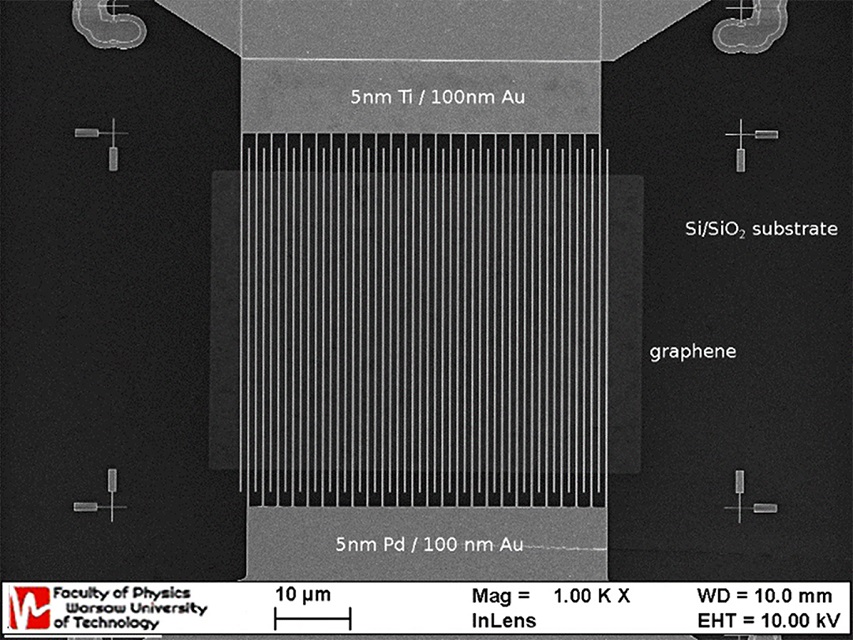How is graphene holding up at the Warsaw University of Technology?

Warsaw University of Technology has been conducting intensive research on graphene for over 10 years, photo: Office for Promotion and Information
The Warsaw University of Technology is among the few Europe’s scientific centers that not only conduct research into graphene and new two-dimensional materials, but also develop graphene-enabled applications.
The Warsaw University of Technology (“WUT”), for more than 10 years, has been involved in extensive research into graphene, its applications and production techniques, in both domestic and international projects (it boasts more than 250 scientific publications in international journals and several patents). As the only institution of higher education in Poland, it is a member of the Graphene Flagship programme, the EU’s biggest ever research initiative. The project work is carried out among others in the cutting-edge Center for Advanced Materials and Technologies (CEZAMAT) and is scheduled to continue until at least March 2022.
The University cooperates with scientific and industrial partners from Sweden, the United Kingdom, Austria and China to further advance the technology of epitaxial graphene on silicon carbide for applications such as 5G technologies. WUT’s PhD students engage in joint research at scientific institutions across Europe, including Cambridge and Madrid.
WUT pursues a number of high-end national projects that focus on research into graphene and new two-dimensional materials: Team-Tech (Foundation for Polish Science), Lider and TechmatStrateg (National Centre for Research and Development), Sonata and Preludium (National Science Centre), Diamentowy Grant (Ministry of Science and Higher Education).
The University has established the Graphene Laboratory (Faculty of Chemistry and Process Engineering) dedicated to the carbon nanomaterial production, characterization and exploration of new applications, e.g. hybrid fluorescent materials or infrared radiation absorbers or even some unusual solutions such as the development of new polyester gelcoats to be used in the construction of new generation yachts, Delphia Nano Solution. It is also a promoter of spin-offs aimed at the transfer of graphene technologies and applications to industry and putting them to use for commercial production. Moreover, numerous businesses collaborate with Warsaw University of Technology in application research under joint projects and bilateral agreements.
The work on graphene at Warsaw University of Technology covers two types of this material: graphene flakes and epitaxial graphene (film). “The University has several processing lines producing graphene flakes with the use of both chemical methods of oxidation and reduction of graphene oxide and the so-called liquid-phase direct exfoliation method. Last year, a new method was launched for the production of graphene flakes which is cheap, green and easily scalable for industry. WUT is now in the process of patenting this new technology,” says Prof. Mariusz Zdrojek, head of the graphene research group at WUT’s Faculty of Physics.
The University has also launched an epitaxial graphene growth (on copper foil) for the purpose of its own application research. Moreover, it has developed and launched the growth technique of new two-dimensional materials in the graphene family, MXenes. The synthesis of other two-dimensional materials, i.e. molybdenum disulfide (MoS2), using the epitaxial growth method has also been elaborated.
Some of the more exciting graphene applications developed by the Warsaw University of Technology in collaboration with the Polish industry include:
- New generation ultrafast infrared photodetector created in 2015 under the Graf-Tech project. The device, in which graphene plays a key role, is in the pre-implementation phase (Faculty of Physics);
- Electronic nanodevices to be used in high-frequency electronics (for fast detectors, sensors or diodes), a product of the Lider project. Currently, work is underway on the patent application (Faculty of Physics);
- New nanocomposites for electromagnetic radiation protection for cybersecurity, electronics, aerospace and 5G technology. The patent application is pending with the European Patent Office (Faculty of Physics);
- Graphene thermal pastes for electronics as novel materials for heat transfer. Conductive graphene inks and pastes suitable for multi-surface printing technologies (e.g. clothes or banknote printing), where they act as transparent electrodes. Patented technology (Faculty of Mechatronics);
- Membrane technologies for mobile drinking water treatment plants, where use of graphene has improved selectivity. (Faculty of Material Science and Engineering; Faculty of Chemical and Process Engineering);
- Graphene as an anti-corrosion coating, a product of the GrafTech project as part of the joint effort with a research partner (Faculty of Physics); and
- other, i.e. flexible displays, pressure sensors, glucose sensors or amino acid biosensors.
For the past few years WUT’s researchers have been also conducting research into the application of other 2D materials. This has resulted in creation of the materials’ potential new applications eg in the production of composites for the space and aerospace industries or as an innovative platform for drug delivery, new optoelectronic nanodevices or devices for terahertz electronics applications.
With the appropriate know-how, materials and infrastructure and access to the country’s best specialists, Warsaw University of Technology remains at the leading edge of the development of technologies and applications for other two-dimensional materials, considered to be of strategic importance to advanced industry sectors.








